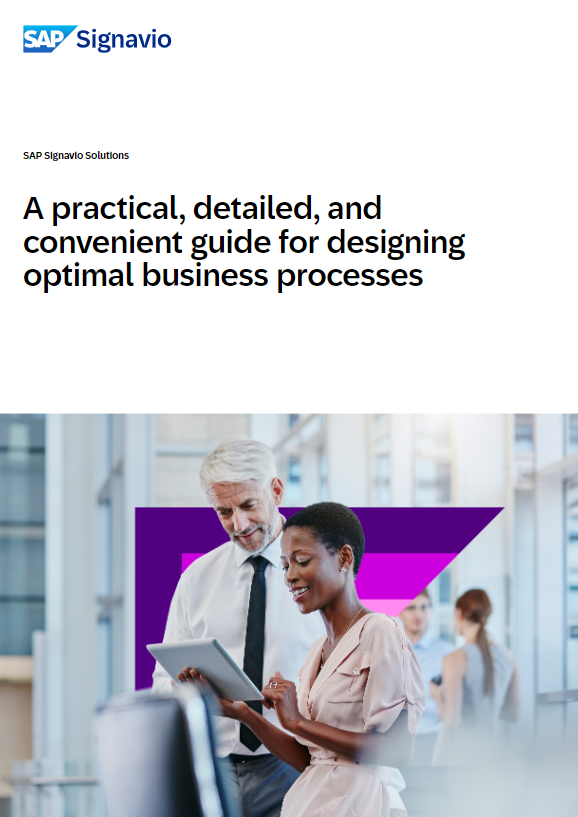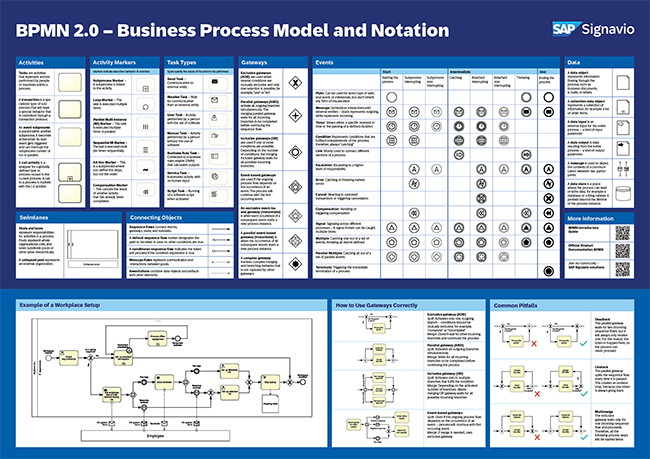Business process analysts work directly with tools for modeling, documentation, and analysis. Their focus is on creating transparency, uncovering inefficiencies, and providing insights for managers and owners.
BPM platforms
BPM software such as SAP Signavio Process Modeler is where analysts document processes end to end. They use it to:
- Model “as-is” and “to-be” processes with BPMN or EPC.
- Maintain central repositories of workflows.
- Ensure process documentation is accessible and up to date.
Analytics & process monitoring tools
Analysts use process mining and KPI dashboards to uncover performance gaps.
- SAP Signavio Process Intelligence allows them to reconstruct event data and identify bottlenecks.
- Dashboards and reports highlight cycle times, error rates, and compliance issues.
- Findings are packaged into insights for managers and owners.
Workflow & automation tools
Analysts do not configure automation but support its design.
- Identify automation opportunities within processes.
- Define requirements for RPA or workflow teams.
- Build business cases for automation initiatives.
Collaboration & documentation platforms
Analysts use platforms like Confluence or SharePoint to manage process information.
- Store documentation, diagrams, and change logs.
- Coordinate stakeholder feedback and reviews.
- Maintain version control during process updates.
Frameworks & methodologies
Analysts follow structured frameworks to guide their work.
- BPM lifecycle phases for discovery, analysis, design, implementation, and optimization.
- Lean Six Sigma to validate improvements with data.
- BPMN/EPC standards to communicate processes clearly across business and IT.
These tools and frameworks help analysts uncover insights and prepare recommendations that feed into process governance and improvement projects.
Career path & advancement
The business process analyst role is a common entry point into the broader field of process management and operational excellence. Analysts gain exposure to how organizations function end to end, making the role a foundation for multiple career directions.
Entry-level
Many analysts begin in supporting positions where they document workflows, gather requirements, and provide data for improvement projects. The focus at this stage is on building analytical skills, learning methodologies, and gaining visibility into business operations.
- Junior business analyst
- Operations coordinator
- Continuous improvement assistant
Mid-level
With 3–5 years of experience, analysts typically move into more independent roles where they lead workshops, analyze KPIs, and build business cases for improvement programs. They may also begin mentoring junior colleagues or coordinating smaller projects.
Executive path
The natural progression from mid-level roles is into senior leadership, where process excellence becomes part of enterprise strategy. These roles require governance, cross-departmental alignment, and the ability to deliver transformation at scale.
Parallel paths
Not all analysts follow the management track. Some branch into specialized roles where they apply their process knowledge in different ways:
- Process owner — accountable for the performance of a specific end-to-end process like order-to-cash.
- Automation developer — translating improvement opportunities into technical solutions with RPA and workflow platforms.
Across all these paths, the unifying theme is that analysts build the foundational knowledge of “how work gets done,” which equips them for leadership or specialization later in their careers.
Salary & demand
Business process analyst salaries vary widely by region, company size, and industry, but the demand for this role is growing across all sectors as organizations push for operational efficiency and digital transformation.
| Region |
Entry-level BPA |
Mid-level BPA |
Senior/Lead BPA roles |
| United States |
$55,000–$70,000 |
$70,000–$90,000 |
$90,000–$110,000+ |
| United Kingdom |
£30,000–£40,000 |
£40,000–£55,000 |
£55,000–£70,000+ |
| Germany (DACH) |
€45,000–€60,000 |
€60,000–€80,000 |
€80,000–€95,000+ |
| India |
₹4L–₹7L |
₹7L–₹12L |
₹12L–₹18L+ |
Sources: Glassdoor, ZipRecruiter, Payscale, Indeed (2024–2025 data). Entry and executive bands extrapolated from verified mid-level anchors.
Demand trends
- Process analysts are particularly sought after in financial services, healthcare, manufacturing, and the public sector, where compliance and efficiency are critical.
- The rise of process mining and automation tools has also increased demand for analysts who can combine technical insight with business knowledge.
- As organizations mature, analysts are expected to work closely with managers, owners, and automation teams, making them indispensable in transformation programs.
These numbers and trends represent industry averages. Actual salaries depend on organizational maturity, regional cost of living, and individual expertise.







